
Frederick Dewayne Hubbard was an American jazz trumpeter. He played bebop, hard bop, and post-bop styles from the early 1960s onwards. His unmistakable and influential tone contributed to new perspectives for modern jazz and bebop.
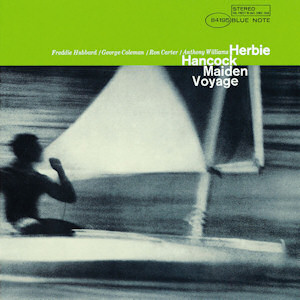
Maiden Voyage is the fifth album led by jazz musician Herbie Hancock, and was recorded by Rudy Van Gelder on March 17, 1965, for Blue Note Records. It was issued as BLP 4195 and BST 84195. Featuring Hancock with tenor saxophonist George Coleman, trumpeter Freddie Hubbard, bassist Ron Carter and drummer Tony Williams, it is a concept album aimed at creating an oceanic atmosphere. As such, many of the track titles refer to marine biology or the sea, and the musicians develop the concept through their use of space. The album was presented with the Grammy Hall of Fame Award in 1999.

Seven Steps to Heaven is the eighth studio album on Columbia Records by jazz musician Miles Davis, released in 1963, catalogue CL 2051 and CS 8851 in stereo. Recorded at Columbia's 30th Street Studios in Manhattan, and at Columbia Studios in Los Angeles, in sessions recorded in April of 1963, and May of 1963. It presents the Miles Davis Quintet in transition, with the New York session introducing the rhythm section of Herbie Hancock, Ron Carter and Tony Williams, who would become Davis' regular sidemen for the next five years. Upon release, the album was Davis' most successful on the Billboard pop LPs chart up to that point, peaking at number 62.
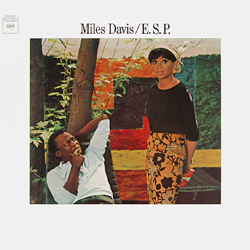
E.S.P. is an album by Miles Davis, recorded on January 20–22, 1965 and released on August 16 of that year by Columbia Records. It is the first release from what is known as Davis's second great quintet: Davis on trumpet, Wayne Shorter on tenor saxophone, Herbie Hancock on piano, Ron Carter on bass, and Tony Williams on drums. The album was named after a tune by Shorter, and was inspired by the fact that, "since Wayne Shorter's arrival, the five members of the quintet seemed to communicate by mental telepathy."

Miles Smiles is an album by jazz musician Miles Davis, released on February 16, 1967 on Columbia Records. It was recorded by Davis and his second quintet at Columbia 30th Street Studio in New York City on October 24 and October 25, 1966. It is the second of six albums recorded by Davis' second great quintet, which featured tenor saxophonist Wayne Shorter, pianist Herbie Hancock, bassist Ron Carter, and drummer Tony Williams.

Nefertiti is a studio album by jazz musician Miles Davis, released in March 1968. Recorded at Columbia's 30th Street Studio over four dates between June 7 and July 19, 1967, the album was Davis' last fully acoustic album. Davis himself did not contribute any compositions – three were written by tenor saxophonist Wayne Shorter, two by pianist Herbie Hancock, and one by drummer Tony Williams.
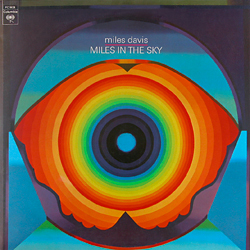
Miles in the Sky is a studio album by American trumpeter and composer Miles Davis, released on July 22, 1968, by Columbia Records. It was the last full album recorded by Davis' "Second Great Quintet" and marked the beginning of his foray into jazz fusion, with Herbie Hancock playing electric piano and Ron Carter playing electric bass guitar on opening track “Stuff”. Additionally, electric guitarist George Benson features on “Paraphernalia”.
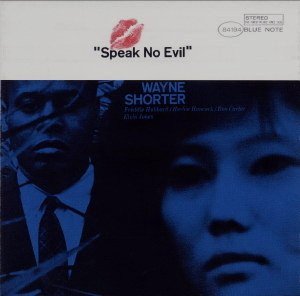
Speak No Evil is the sixth album by Wayne Shorter. It was released in June 1966 by Blue Note Records. The music combines elements of hard bop and modal jazz, and features Shorter on tenor saxophone, trumpeter Freddie Hubbard, pianist Herbie Hancock, bassist Ron Carter and drummer Elvin Jones. The cover photo is of Shorter's first wife, Teruko (Irene) Nakagami, whom he met in 1961.

Empyrean Isles is the fourth studio album by American jazz pianist Herbie Hancock, recorded on June 17, 1964 and released on Blue Note in November later that year. The quartet features trumpeter Freddie Hubbard and rhythm section Ron Carter and Tony Williams.
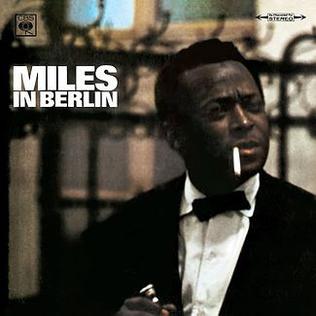
Miles in Berlin is an live album by Miles Davis performed at the Berliner Philharmonie on September 25, 1964 with his "Second Great Quintet," featuring tenor saxophonist Wayne Shorter, pianist Herbie Hancock, bassist Ron Carter and drummer Tony Williams, marking their first recorded work.

A Tribute to Miles is a tribute album recorded by the then surviving members of the Miles Davis "Second Great" Quintet: pianist Herbie Hancock, saxophonist Wayne Shorter, bassist Ron Carter and drummer Tony Williams. Taking the Davis role was trumpeter Wallace Roney.

Quartet is the thirty-fourth album by jazz pianist Herbie Hancock, featuring a quartet with trumpeter Wynton Marsalis, bassist Ron Carter and drummer Tony Williams. It was originally issued in Japan on CBS/Sony, and later given a US release by Columbia.
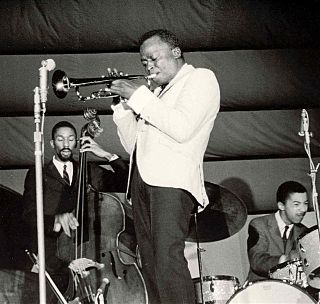
The Miles Davis Quintet was an American jazz band from 1955 to early 1969 led by Miles Davis. The quintet underwent frequent personnel changes toward its metamorphosis into a different ensemble in 1969. Most references pertain to two distinct and relatively stable bands: the First Great Quintet from 1955 to 1959, and the Second Great Quintet from late 1964 to early 1969, Davis being the only constant throughout.

Water Babies is a compilation album by American jazz trumpeter Miles Davis. It compiled music Davis recorded in studio sessions with his quintet in 1967 and 1968, including outtakes from his 1968 album Nefertiti and recordings that foreshadowed his direction on In a Silent Way (1969), while covering styles such as jazz fusion and post-bop. Water Babies was released by Columbia Records in 1976 after Davis had (temporarily) retired.

V.S.O.P. is a 1977 double live album by keyboardist Herbie Hancock, featuring acoustic jazz performances by the V.S.O.P. Quintet, jazz fusion/ jazz-funk performances by the ‘Mwandishi’ band and The Headhunters.

Miles in Tokyo is a live album recorded on July 14, 1964, by the Miles Davis Quintet at the Tokyo Kōsei Nenkin Kaikan, Shinjuku, Tokyo, Japan. It was released in the United States on CD in 2005 and is the first recording of Davis in Japan. It is the only album to showcase an early incarnation of his Second Great Quintet featuring Sam Rivers on tenor saxophone, following George Coleman's departure; after this, Wayne Shorter's appointment completed the classic lineup which recorded such albums as ESP and Miles Smiles, through to Miles in the Sky.
V.S.O.P. was an American jazz quintet consisting of Herbie Hancock, Wayne Shorter, Ron Carter (bass), Tony Williams (drums), and Freddie Hubbard . Hancock, Shorter, Carter, and Williams had all been members of Miles Davis' "Second Great Quintet" during the 1960s. The name V.S.O.P. is taken from a grade of Cognac brandy, where it signifies aged stock.

Directions is a compilation album by American jazz musician Miles Davis, released in 1981 by Columbia Records. It collects previously unreleased outtakes that Davis recorded between 1960 and 1970. Directions was the last of a series of compilation albums—mostly consisting of, at that time, previously unreleased music—that Columbia released to bridge Davis' recording hiatus that ended with the Man with the Horn in July 1981.

Live in Europe 1967: The Bootleg Series Vol. 1 is a 3 CD + 1 DVD live album of Miles Davis and his "Second Great Quintet," with saxophonist Wayne Shorter, pianist Herbie Hancock, bassist Ron Carter, and drummer Tony Williams. The CDs contain recordings of three separate concerts in Europe, and the DVD has two additional concerts from Karlsruhe and Stockholm.

Miles Davis at Newport 1955–1975: The Bootleg Series Vol. 4 is a four-CD album compiling five of Miles Davis's performances at the Newport Jazz Festival in Newport, Rhode Island and two European concerts branded under the Festival moniker with one additional track recorded in New York City.



















